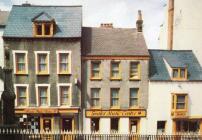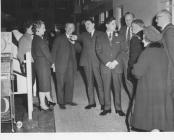Content can be downloaded for non-commercial purposes, such as for personal use or in educational resources.
For commercial purposes please contact the copyright holder directly.
Read more about the The Creative Archive Licence.
Description
Dedication: St Catwg
Denomination: Anglican
Built: 13th century
Rebuilt/restored: 1866
Photography: Leon Morgan
Date: 30 July 2011
Camera: Sony DSC-W190 compact digital
Note 1: The spacious nave and chancel are probably of 13th century origin and the tower and porch are early 16th century, but all the windows plus the northern buttresses and vestries are Victorian. [Source: The Old Parish Churches of Gwent, Glamorgan & Gower by Mike Salter, published 1991, Folly Publications, Malvern; ISBN 1-871731-08-9]
Note 2: A new incumbent in 1862 inherited a church that was in a bad state of repair. After the collapse of the entire roof in September 1866, Canon Gilbert Harries quickly set about repairs, and completion of the work, and the re-opening of the church, were celebrated before Christmas. The restored sanctuary and chancel present a picture of 'Victorians' within a Norman shell, for much of which was installed was contemporary with Canon Harries's time. The records of the work on the nave after its collapse show the type of building that had previously existed. Timber was obtained from Canon Harries's Llanuwas estate in Pembrokeshire, the pulpit being made at Solva. The nave had plastered walls and ceiling, the wall plaster remaining until 1903 when, because of stains arising from dampness it was removed. The large south side windows are 20th century installations - the original windows were small and one of them is to be seen in the Lady Chapel to which it was removed to provide light to what until recently, was the clergy vestry. The churchyard contains few memorial stones from as early as the 18th century for until then, the parishioners were buried within the church, some of their resting places in the Chancel being recorded on small brass plate. Their memorial stones in the nave lie benesth the pews. In 1699 Robert Thomas, terrier of parish customs, set down a scale of burial fees in respect of these, when it cost eightpence to be buried in the Chancel and fourpence and threepence in the nave.
Until well into the 19th century the ecclesiastical parish [of Gelligaer] extended over much of northeast Glamorgan, an area that spread northwards from Ystrad Mynach to the borders of Brecknockshire, and the only Anglican places of worship were the parish church [St Catwg's] and a chapel of ease at Cefn Brithdir. Industrial development now began to create the need for the spiritual and educational service to an ever-growing number of people who lived in the villages lying too remote from the churches. New churches, which were used as day schools, began to be built at Pontlottyn, Pantywaun, Troedyrhiwfuwch and Deri. After 1870, when education became a State responsibility, churches and missions were opened in the remaining villages of the parish. [Source: Parish of Gelligaer website (accessed 4 May 2016)]








Do you have information to add to this item? Please leave a comment
Comments (0)
You must be logged in to leave a comment